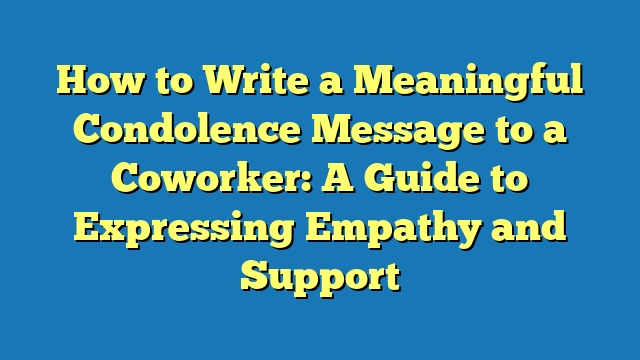A condolence message to coworker is a message expressing sympathy and offering support to a colleague who has experienced a loss of a loved one or a friend. For instance, “My deepest condolences on the passing of your father. I know how close you were to him.”
Condolence messages are important because they provide emotional support during a difficult time. They can also help build relationships between coworkers and strengthen company culture.
Historically, condolence messages were often written in letters or on sympathy cards. However, today they are often sent via email or instant messaging.
Condolence Message to Coworker
Condolence messages offer support and sympathy to colleagues during times of loss and grief.
- Empathy: Understanding and sharing their feelings.
- Sincerity: Expressing genuine condolences.
- Brevity: Keeping the message concise and respectful.
- Personalization: Including specific memories or anecdotes.
- Professionalism: Maintaining a respectful and appropriate tone.
- Timeliness: Sending the message promptly after learning of the loss.
- Offer support: Let them know you’re there for them.
- Respect boundaries: Give them space if they need it.
- Follow-up: Check in with them later to see how they’re doing.
- Cultural considerations: Be aware of any cultural sensitivities.
Empathy, sincerity, and personalization are key aspects of an effective condolence message, as they demonstrate genuine care and support for the grieving colleague. The message should be brief and professional, yet personal enough to show that you understand their loss. It’s important to offer support and respect their boundaries, and to follow up later to show that you’re still thinking of them.
Empathy
In the context of a condolence message to coworker, empathy is of utmost importance as it allows the sender to convey genuine understanding and support during a time of grief and loss.
-
Emotional Validation
Acknowledging and validating the colleague’s emotions, letting them know that their feelings are normal and understandable.
-
Active Listening
Giving the colleague space to express their feelings without judgment or interruption, demonstrating active listening skills.
-
Perspective Taking
Attempting to understand the colleague’s perspective and see the situation from their point of view, fostering a deeper connection.
-
Nonverbal Cues
Paying attention to nonverbal cues such as body language and tone of voice, which can convey empathy and support even without words.
By incorporating these facets of empathy into a condolence message, the sender can create a message that is both meaningful and supportive, providing comfort and solace to the grieving colleague.
Sincerity
In the context of a condolence message to coworker, sincerity is a critical component that lends authenticity and depth to the message. It goes beyond mere words and conveys a genuine sense of empathy and support during a time of grief and loss.
Expressing genuine condolences involves acknowledging the colleague’s loss, understanding their pain, and offering words of comfort that come from the heart. It requires the sender to be present and attentive, listening to the colleague’s emotions and responding with compassion and understanding.
Real-life examples of sincerity in a condolence message to coworker include:
- “I am so sorry to hear about the loss of your father. He was a wonderful man, and I know how much you loved him.”
- “My deepest condolences on the passing of your mother. She was a kind and caring woman, and I will always remember her fondly.”
- “I can’t imagine what you must be going through right now. Please know that I am here for you if you need anything at all.”
Understanding the importance of sincerity in a condolence message to coworker has practical applications in the workplace. When a colleague experiences a loss, it is essential to offer genuine support and condolences. By expressing sincerity, the sender can create a message that is both meaningful and supportive, providing comfort and solace to the grieving colleague.
Brevity
Brevity is a critical component of a condolence message to a coworker. When someone is grieving, they may not have the energy or attention span to read a long message. A brief message is more likely to be read and appreciated.
In addition, being respectful means being mindful of the other person’s time and emotions. A long message may come across as overwhelming or intrusive. A brief message, on the other hand, shows that you are respectful of the other person’s space and time.
Here are some tips for writing a brief condolence message to a coworker:
- Keep it simple. Avoid using jargon or technical terms.
- Be specific. Mention the person who died, if possible.
- Offer your condolences. Express your sympathy and support.
- Keep it short. A few sentences is all that is necessary.
Here is an example of a brief condolence message to a coworker:
“I am so sorry to hear about the loss of your father. He was a wonderful man, and I know how much you loved him. Please accept my deepest condolences.”
Personalization
In a condolence message to a coworker, personalization is a crucial aspect that adds depth and meaning to the message. It involves including specific memories or anecdotes that you shared with the deceased, demonstrating a genuine connection and understanding of their life.
When you personalize a condolence message, you acknowledge the unique relationship that you had with the deceased and show that you valued their presence in your life. This can provide great comfort to the grieving coworker, as it helps them to remember the positive impact that their loved one had on others.
Here are some examples of how to personalize a condolence message to a coworker:
- “I remember when we worked on that project together, and you always had a way of making me laugh, even when things were tough.”
- “I’ll never forget the time we went to that conference together and you gave such an inspiring presentation. I was so proud to work alongside you.”
- “I’m so grateful for the friendship we had. You were always there for me, through thick and thin.”
Including specific memories or anecdotes in a condolence message shows that you have taken the time to reflect on your relationship with the deceased and that you genuinely care about the grieving coworker. It is a simple yet powerful way to offer comfort and support during a difficult time.
Professionalism
Professionalism is a critical component of a condolence message to a coworker. When someone is grieving, they are particularly vulnerable and sensitive. It is important to be respectful of their emotions and to avoid saying anything that could be hurtful or offensive.
A respectful tone means being mindful of your words and actions. It means avoiding using slang or jargon, and being careful not to make any assumptions about the other person’s beliefs or values. It also means being sensitive to the other person’s body language and nonverbal cues.
An appropriate tone means using language that is appropriate for the situation. For example, it is not appropriate to use humor in a condolence message. It is also important to be aware of the cultural context of the situation. For example, in some cultures it is considered disrespectful to speak directly about death.
Maintaining a professional and respectful tone in a condolence message shows that you are sensitive to the other person’s feelings and that you are offering your support in a genuine and sincere way.
Timeliness
Timeliness is an important aspect of a condolence message to a coworker. When someone is grieving, they need to know that their friends and colleagues are thinking of them. Sending a condolence message promptly after learning of the loss shows that you care about the person and that you are there to support them.
In some cases, it may be difficult to know what to say in a condolence message. However, it is important to remember that the most important thing is to express your sympathy and support. You can do this by simply saying that you are sorry for the person’s loss, or by sharing a memory of the deceased.
Here are some examples of timely condolence messages that you can send to a coworker:
- “I was so sorry to hear about the loss of your father. He was a wonderful man, and I know how much you loved him.”
- “I am thinking of you during this difficult time. Please let me know if there is anything I can do to help.”
- “I will always remember your mother’s kindness and generosity. She was a truly special person.”
Sending a timely condolence message to a coworker is a simple but meaningful way to show your support. It can make a big difference to someone who is grieving.
Offer support
Within the context of a condolence message to a coworker, offering support is a crucial aspect that goes beyond mere words of sympathy. It involves expressing genuine empathy and conveying a willingness to provide tangible assistance during a time of grief and loss.
-
Emotional Support
Acknowledging and validating the coworker’s emotions, listening attentively without judgment, and providing a safe space for them to express their feelings.
-
Practical Assistance
Offering specific help with tasks or errands, such as running errands, preparing meals, or taking care of other responsibilities, to alleviate the burden during this challenging time.
-
Companionship and Presence
Making time to simply be present for the coworker, engaging in activities that provide comfort and distraction, such as going for walks, sharing stories, or offering a listening ear.
-
Respecting Boundaries
Understanding and respecting the coworker’s need for space and privacy, giving them the time and space they need to grieve and process their loss.
By incorporating these facets of offering support into a condolence message to a coworker, the sender can create a message that provides not only emotional comfort but also tangible assistance, demonstrating genuine care and support during a difficult time.
Respect boundaries
In the context of a condolence message to coworker, respecting boundaries is a crucial aspect that acknowledges the need for space and privacy during a time of grief and loss. It involves understanding that the coworker may require time and solitude to process their emotions and come to terms with their loss.
-
Understanding the Need for Space
Recognize that everyone grieves differently and may need varying degrees of space and time to process their emotions. Allow the coworker to set the pace and boundaries for communication and interaction.
-
Providing Physical Space
Respect the coworker’s physical space by giving them room to be alone if desired. Avoid overwhelming them with constant presence or physical contact, unless they explicitly express a need for it.
-
Respecting Communication Boundaries
Be mindful of the coworker’s communication preferences and boundaries. Give them space if they need time to respond to messages or phone calls, and avoid pressuring them to engage in conversations when they may not be ready.
-
Allowing for Privacy
Respect the coworker’s need for privacy and confidentiality. Avoid gossiping or sharing personal information about their loss without their consent. Allow them to share their feelings and experiences on their own terms.
Respecting boundaries in a condolence message to coworker demonstrates empathy, understanding, and support. It allows the coworker to grieve at their own pace and in their own way, providing them with the space they need to heal and cope with their loss.
Follow-up
In the context of a condolence message to coworker, follow-up is a critical component that demonstrates ongoing support and care beyond the initial expression of sympathy. It involves reaching out to the coworker at a later date to check on their well-being and offer continued support during their grieving process.
The importance of follow-up lies in its ability to provide reassurance and remind the coworker that they are not alone in their grief. It allows you to show that you genuinely care about their well-being and that you are committed to supporting them in the long run. By checking in later, you can assess whether they need additional assistance or simply provide a listening ear for them to express their feelings.
Real-life examples of follow-up within a condolence message to coworker include:
- Sending a text message a few days after the initial message, asking how they are doing and if they need anything.
- Calling the coworker to check in and offer to meet for coffee or lunch to talk about their loss.
- Sending a card or small gift, such as a sympathy plant or a book of poems, to show that you are thinking of them.
Understanding the importance of follow-up in a condolence message to coworker has practical applications in the workplace. When a colleague experiences a loss, it is essential to offer ongoing support and follow-up to demonstrate your care and concern. By checking in with them later, you can help to create a supportive and compassionate work environment and foster stronger relationships with your coworkers.
Cultural considerations
When sending a condolence message to a coworker, it is important to be aware of any cultural sensitivities that may exist. Different cultures have different customs and beliefs surrounding death and mourning, and it is important to be respectful of these differences.
For example, in some cultures it is considered disrespectful to speak directly about the deceased. In other cultures, it is considered important to offer specific condolences for the family of the deceased. It is important to research the cultural background of your coworker before sending a condolence message so that you can avoid saying or doing anything that could be offensive.
Here are some examples of cultural considerations to keep in mind when sending a condolence message to a coworker:
- In some cultures, it is considered disrespectful to speak directly about the deceased. Instead, you may want to offer your condolences to the family of the deceased or to the coworker’s community.
- In other cultures, it is considered important to offer specific condolences for the family of the deceased. You may want to mention the name of the deceased family member in your message, and offer your condolences for their loss.
- It is important to be aware of the cultural context of the situation. For example, in some cultures it is considered disrespectful to send flowers to a funeral. In other cultures, flowers are seen as a symbol of sympathy and support.
By being aware of cultural sensitivities, you can send a condolence message that is both respectful and supportive.
Condolence Message to Coworker FAQs
This section addresses commonly asked questions and concerns regarding condolence messages to coworkers, providing guidance on appropriate etiquette and offering insights into the significance of cultural sensitivities.
Question 1: What is the purpose of a condolence message to a coworker?
A condolence message expresses sympathy and support to a colleague who has experienced a loss. It acknowledges their grief and offers words of comfort and reassurance.
Question 2: What are some key elements to include in a condolence message?
Empathy, sincerity, personalization, brevity, professionalism, and timeliness are crucial elements to consider when crafting a condolence message.
Question 3: How can I offer support to my coworker in a condolence message?
Express your condolences, acknowledge their loss, listen attentively, and offer specific assistance or support, while respecting their boundaries and giving them space if needed.
Question 4: What are some cultural considerations to keep in mind?
Be aware of cultural sensitivities and customs surrounding death and mourning. Research the background of your coworker to avoid saying or doing anything that could be offensive.
Question 5: Can I send a condolence message even if I didn’t know the deceased personally?
Yes, it is appropriate to send a condolence message even if you didn’t know the deceased personally. Your message can express sympathy and support for your coworker during their time of grief.
Question 6: Is it okay to send a condolence message via email or text?
While traditional methods like letters or cards are still appropriate, it is acceptable to send a condolence message via email or text, especially if it is a timely and convenient way to reach out.
These FAQs provide essential guidance for expressing condolences to a coworker in a respectful and meaningful way. Understanding the importance of empathy, cultural awareness, and timely support can help you offer genuine comfort and show your support during a difficult time.
In the next section, we will delve deeper into the significance of clear and professional communication in condolence messages, exploring best practices and common pitfalls to avoid.
Tips for Writing a Condolence Message to a Coworker
Crafting a thoughtful and appropriate condolence message can be challenging. Here are some practical tips to guide you in expressing your sympathy and support:
Tip 1: Be Sincere and Empathetic
Convey genuine sympathy and understanding by acknowledging the loss and expressing your heartfelt condolences.
Tip 2: Personalize the Message
Add a personal touch by mentioning a specific memory or quality of the deceased that you shared with your coworker.
Tip 3: Offer Specific Support
Inquire about specific ways you can help, such as offering practical assistance with tasks or simply providing a listening ear.
Tip 4: Respect Boundaries
Understand that your coworker may need space and time to grieve. Respect their wishes and avoid overwhelming them with constant communication.
Tip 5: Consider Cultural Customs
Be mindful of any cultural sensitivities or traditions related to death and mourning. Research or ask your coworker about appropriate customs.
Tip 6: Proofread Carefully
Before sending your message, proofread it thoroughly to ensure there are no errors in grammar or spelling.
Summary: By following these tips, you can create a condolence message that is both meaningful and supportive. It will demonstrate your empathy, respect, and willingness to help your coworker during this difficult time.
These practical tips serve as a foundation for crafting a thoughtful condolence message. In the next section, we will delve into the importance of maintaining professionalism and etiquette in workplace communications, ensuring your message is both appropriate and impactful.
Abschluss
Diese Abhandlung hat die Bedeutung von Beileidsbekundungen an Kollegen am Arbeitsplatz beleuchtet und wertvolle Einblicke in die wesentlichen Elemente, kulturellen berlegungen und bewhrten Praktiken gegeben. Die Aufrichtigkeit, Empathie, Personalisierung und Professionalitt sind dabei von entscheidender Bedeutung, um eine sinnvolle und untersttzende Botschaft zu bermitteln.
Indem wir diese Prinzipien befolgen, knnen wir ein Arbeitsumfeld schaffen, das von Mitgefhl, Respekt und gegenseitiger Untersttzung geprgt ist. Beileidsbekundungen sind ein einfaches, aber wirkungsvolles Mittel, um Trauernden in ihrer dunkelsten Stunde Trost zu spenden und ihnen zu zeigen, dass sie nicht allein sind. Mgen wir alle danach streben, mitfhlende und verstndnisvolle Kollegen zu sein, die in Zeiten der Not freinander da sind.









Tips for Using "Template by Kevin Crafts" Comments for Meaningful Online Discussions